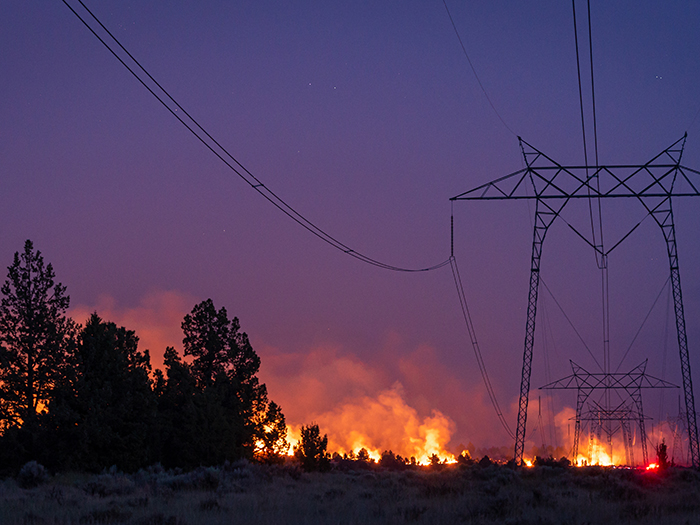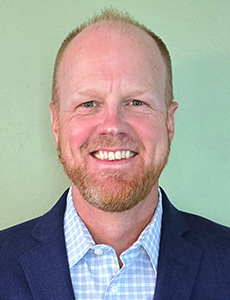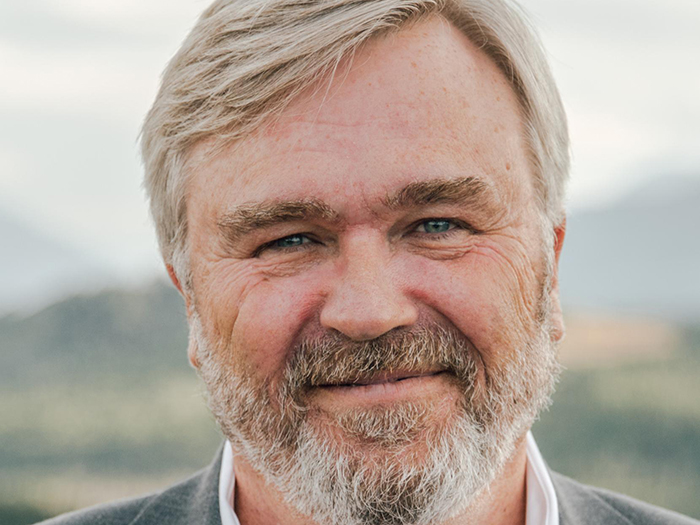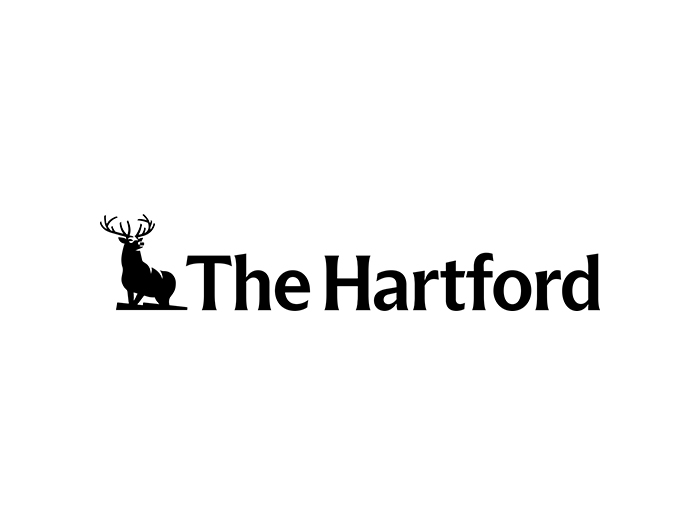Sponsored Content by The Hartford
How Energy Companies Are Working to Mitigate Wildfire Risks

Wildfire is a particularly challenging exposure for carriers to underwrite. Weather conditions can change from month to month: If it’s drier, the risk of a fire igniting rises, and if a particular territory sees a lot of rain, spark risk goes down in the short term — but vegetation nourished by that same moisture can become a fire hazard when it dries out later on.
Wildfire risk, as proven in multiple states across the Western United States, may be particularly problematic for energy and utility companies, regardless of whether they are “traditional” producers of energy or in the renewables field.
Across multiple Western states, utility companies charged with delivering electricity to homeowners and commercial enterprises can find themselves the target of lawsuits if the wires they own fall in high winds and ignite wildfires.
But fire risk in the energy sector is not limited to that scenario. Lightning strikes can set wind turbine blades on fire, and thermal runaway (in which high temperatures can cause batteries to ignite) can cause fierce fires in battery energy storage systems. Solar farms need to connect to the grid using belowground or aboveground cables, which are susceptible to damage that could cause a fast-moving fire.
Wildfire risk has become so widespread and, in some places, so severe that energy companies seeking to build solar farms or wind farms have had to reconsider their site location decisions. This can impede the growth of renewable energy sources, which in turn places more pressure on suppliers and distributors to deliver the energy their customers require in adequate volumes.
As carriers reassess their appetite for wildfire risks, insureds in the energy sector may want to reconsider their risk mitigation efforts. If they can protect their properties and reduce the risk of a fire breaking out, securing the needed coverage should be easier and less expensive. Insurers, for their part, are developing better modeling tools to more accurately assess risk.
Insurers are also being more proactive in the area of risk mitigation. More and more, they are offering risk engineering advice to their customers in the form of brush removal guidelines and upgrades such as vent covers that can prevent embers from infiltrating buildings.
Expanding Wildfire Risks Threaten Energy Companies

Todd Wilson, Leader of Domestic Energy Casualty, The Hartford
Energy companies face wildfire risks across inland marine and property and casualty insurance, though for different reasons.
“We have seen more wildfire-related activity. These incidents have been primarily affiliated with power generation or electrical co-op risks,” said Todd Wilson, leader of domestic energy casualty, The Hartford.
Claims costs are rising too. Each year, U.S. wildfires cost between $394 billion and $893 billion, according to a Congressional Joint Economic Committee report. Part of this is the result of gaps between what insureds estimate their properties are worth and the actual cost to rebuild — which inflation has increased.
Some companies are expanding the size of their properties, contributing to increased costs.
In particular, energy-intensive data centers, which power AI technology, are increasing the demand for all types of electrical generation. “With larger energy draws, many are embracing on-site power through a combination of gas-fired turbines, photovoltaic solar panel arrays, fuel cells and battery storage. This push to larger local infrastructure translates to higher total insured values, potentially raising the costs of rebuilding after a loss,” said Loren Kippels, inland marine underwriting officer, The Hartford.

Loren Kippels, Inland Marine Underwriting Officer, The Hartford
Renewable energy companies face additional risks, in some cases, because of the technologies they use. “In the solar space, the presence of a battery energy storage system on site poses a higher risk compared to a typical array field without BESS,” Wilson said. “There is considerable overlap between the casualty and property aspects when underwriting these exposures.”
In these cases, carriers will likely assess how well insureds maintain their transmission lines in order to determine what level of threat they face.
Still, “wildfire risk does not only impact renewables,” Wilson said. Other traditional energy businesses also need to be concerned about their exposures as they’re considering what insurance coverage they need.
As stated above, utility companies that deliver electricity using overhead wires are at increased litigation and replacement cost risk as more frequent and intense windstorms affect their infrastructure.
Seek Out a Standard Market Carrier for Support
Fortunately, insureds and their brokers can find the right carrier partner to tackle wildfire risks. The Hartford is committed to educating its customers about the exposure and helping them deploy risk mitigation solutions.
“It’s clear what we’re up against and what we’re striving to accomplish to support our clients,” Wilson said. “Wildfire underwriting is paramount, and we work with our broking partners to help insureds operate better businesses.”
One way The Hartford is addressing increased wildfire risk is by helping energy companies to identify opportunities for and implement risk management solutions, such as clearing brush or flagging locations with reduced exposure.
Education is an important first step in this process. “When solar panels faced mounting claims due to hail damage, The Hartford began working with our clients to better understand the peril. Insights like prior hail history and modeled loss potential allow for informed decisions, including potentially selecting less vulnerable locations. Similarly, when assessing wildfire exposures for a prospect or current insured, we model, underwrite and partner with risk engineering to help mitigate exposures as they expand or grow in low to moderate wildfire risk areas,” Kippels said.
“We can advise them up front about locations where obtaining coverage might be exceedingly difficult and where we, as a standard market, can provide support.”
Improved wildfire models play a critical role in helping protect properties from wildfire. The Hartford’s modeling tools are continuously updated, so they can assess how risk might shift due to increased rain, wind speeds and other factors that contribute to wildfire vulnerability.
“Our models are designed to be up-to-date and reflective of current weather patterns,” Wilson said. “This means that our assessment of a given geographic territory can change from one quarter to the next based on factors such as lack of rain, moisture and heat.”
To learn more, visit: https://www.thehartford.com/.
The information provided in these materials is intended to be general and advisory in nature. It shall not be considered legal advice. The Hartford does not warrant that the implementation of any view or recommendation contained herein will: (i) result in the elimination of any unsafe conditions at your business locations or with respect to your business operations; or (ii) be an appropriate legal or business practice. The Hartford assumes no responsibility for the control or correction of hazards or legal compliance with respect to your business practices, and the views and recommendations contained herein shall not constitute our undertaking, on your behalf or for the benefit of others, to determine or warrant that your business premises, locations or operations are safe or healthful, or are in compliance with any law, rule or regulation. Readers seeking to resolve specific safety, legal or business issues or concerns related to the information provided in these materials should consult their safety consultant, attorney or business advisors. All information and representations contained herein are as of September 2024.
Links from this site to an external site, unaffiliated with The Hartford, may be provided for users’ convenience only. The Hartford does not control or review these sites nor does the provision of any link imply an endorsement or association of such non-Hartford sites. The Hartford is not responsible for and makes no representation or warranty regarding the contents, completeness or accuracy or security of any materials on such sites. If you decide to access such non-Hartford sites, you do so at your own risk.
![]()
This article was produced by the R&I Brand Studio, a unit of the advertising department of Risk & Insurance, in collaboration with The Hartford. The editorial staff of Risk & Insurance had no role in its preparation.








